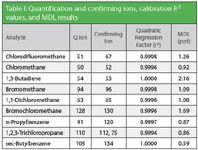UCMR 3 Low-Level VOC Analysis by Purge and Trap Concentration and GC-MS Using Selective Ion Monitoring
The Application Notebook
The United States Environmental Protection Agency (US EPA) has established the Unregulated Contaminant Monitoring Program to collect data for contaminants suspected to be present in drinking water (1). The US EPA is currently proposing Unregulated Contaminant Monitoring Rule 3 (UCMR 3) which will collect data from January 2013 through December 2015. Because of the impact on public health and safety, it is vital to have a system that can detect and analyze for these compounds at low levels.
The United States Environmental Protection Agency (US EPA) has established the Unregulated Contaminant Monitoring Program to collect data for contaminants suspected to be present in drinking water (1). The US EPA is currently proposing Unregulated Contaminant Monitoring Rule 3 (UCMR 3) which will collect data from January 2013 through December 2015. Because of the impact on public health and safety, it is vital to have a system that can detect and analyze for these compounds at low levels. This study will validate the analysis of the volatile organic compounds (VOCs) present on the UCMR 3 analyte list. These compounds can be found in Table I. US EPA Method 524.3, used to monitor the VOCs, allows for the use of single ion monitoring (SIM) to reach the part-per-trillion (ppt) levels required by UCMR 3 (2).
Experimental-Instrument Conditions
The Stratum PTC and AQUATek 100 autosampler were coupled to the Thermo ISQ GC–MS system for analysis. The Thermo ISQ was configured with a Restek Rtx-624 20 m × 0.18 mm × 1.0 µm column.
A Tekmar proprietary #9 trap was the analytical trap of choice.
Calibration Data and Method Detection Limits
From a 1 ppm stock solution, an eight-point calibration curve from 2.5–1000 ppt was prepared in de-ionized water. Thermo Scientific EnviroLab Forms software was used to process the calibration data. Figure 1 illustrates quantification and confirming ions for 1,2,3-trichloropropane (TCP). Curve data was evaluated using quadratic regression, with equal weighting. The results of these calibrations can be found in Table I.

Table I: Quantification and confirming ions, calibration R2 values, and MDL results
Method detection limits (MDLs) were established by analyzing seven replicate samples at a concentration of 10 ppt for each contaminant. MDL results can be found in Table I.

Figure 1: Quantification ion (110 m/z) and confirming ions (112 m/z and 75 m/z) for TCP.
Conclusions
The US EPA has established the Unregulated Contaminant Monitoring Program to collect data for contaminants suspected to be present in drinking water. The current proposal, UCMR 3, will collect data on 30 contaminants from January 2013 through December 2015. This study validates the capability of Teledyne Tekmar Stratum PTC and AQUATek 100 Autosampler coupled with a Thermo ISQ for low-level detection of the nine VOC contaminants listed in UCMR 3.
Using a SIM scan, MDLs were established for all VOC contaminants to be monitored according to UCMR 3. With concerns for public health and safety, notification levels of harmful compounds are being pushed lower and lower, driving the demand for more sensitive instrumentation. All contaminants in this study had MDL levels under 2.5 ppt, proving purge and trap to be a superb analytical tool for this analysis.
References
(1) Unregulated Contaminant Monitoring Program, http://water.epa.gov/lawsregs/rulesregs/sdwa/ucmr/.
(2) US EPA Method 524.3, "Measurement of Purgeable Organic Compounds by Capillary Column Gas Chromatography/Mass Spectrometry (GC/MS)," Revision 1, 2009.
Teledyne Tekmar
4736 Socialville Foster Rd., Mason, OH 45040
Tel. (800) 874-2004
Website: www.tekmar.com

Separation of Ultra-Short and Long Chain PFAS Compounds Using a Positive Charge Surface Column
December 11th 2024A separation of ultra-short and long chain PFAS (C1-C18) is performed on a HALO®PCS Phenyl-Hexyl column along with a HALO®PFAS Delay column which demonstrates excellent retention for both hydrophilic and hydrophobic analytes.

.png&w=3840&q=75)

.png&w=3840&q=75)



.png&w=3840&q=75)



.png&w=3840&q=75)














